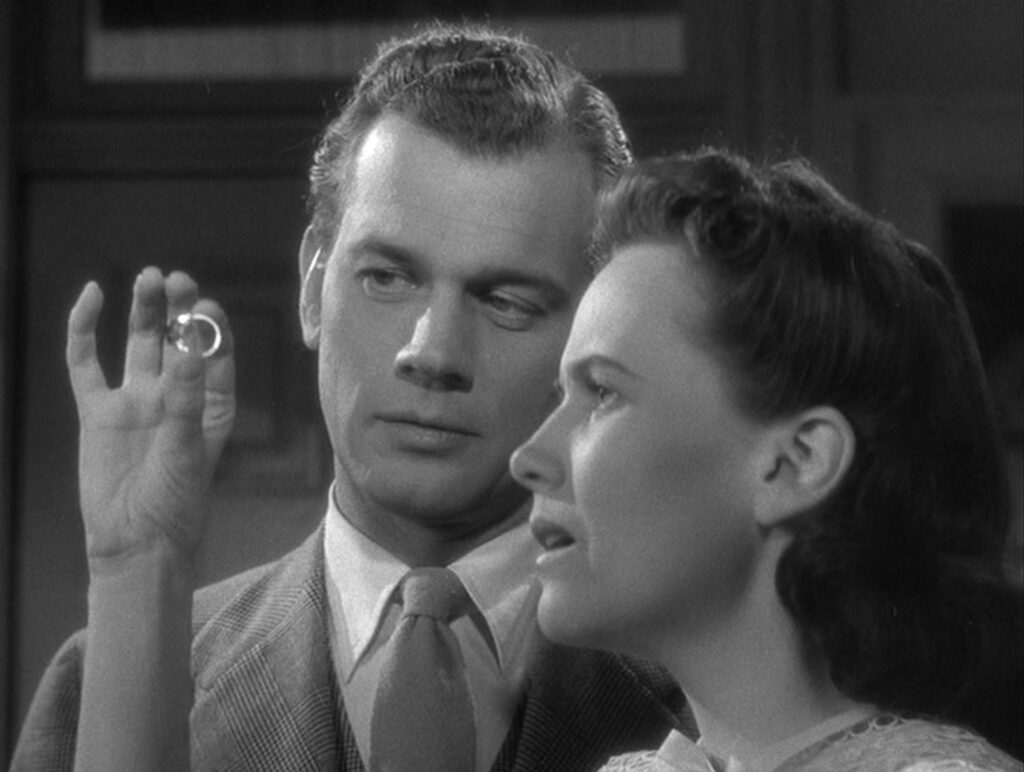
Shadow of a Doubt
1943, directed by Alfred Hitchcock
In J.R.R. Tolkien’s Lord of the Rings saga, twenty rings with magical powers are scattered through Middle Earth, of which one ring “rules them all”. Whoever holds that ring is master of the other twenty and potential lord of Middle Earth. Shadow of a Doubt may not feel similar to Tolkien’s fantastic tale, but Uncle Charlie gives his niece a ring that confers an almost magical power on its bearer. The ring changes hands three times:
1. In the first dinner scene, Uncle Charlie gives the ring as a special gift to young Charlie;
2. In the ‘Til-Two café, Charlie gives it back to her uncle;
3. After Uncle Charlie’s speech, his niece finds it again and comes downstairs wearing it for all to see.
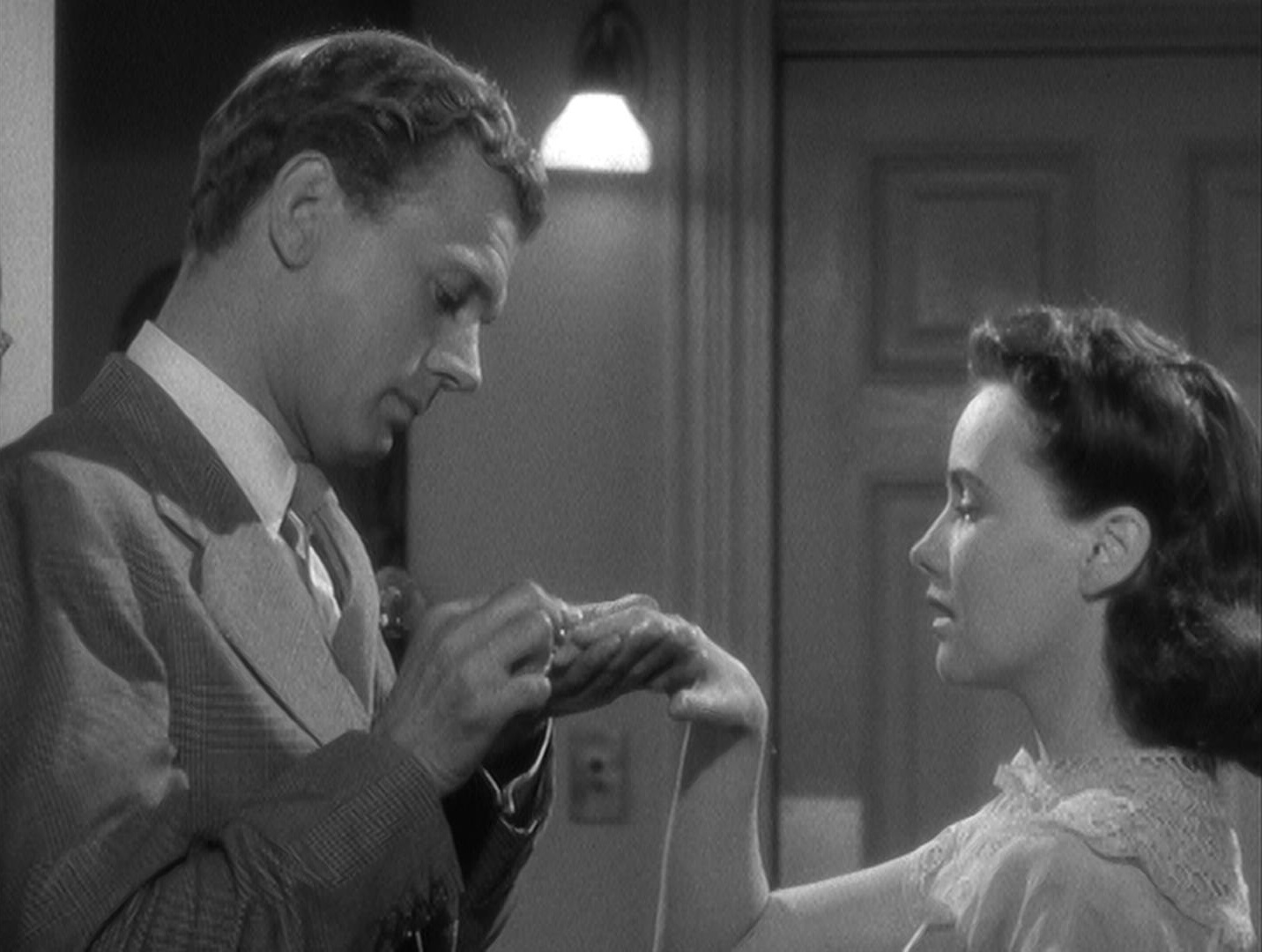
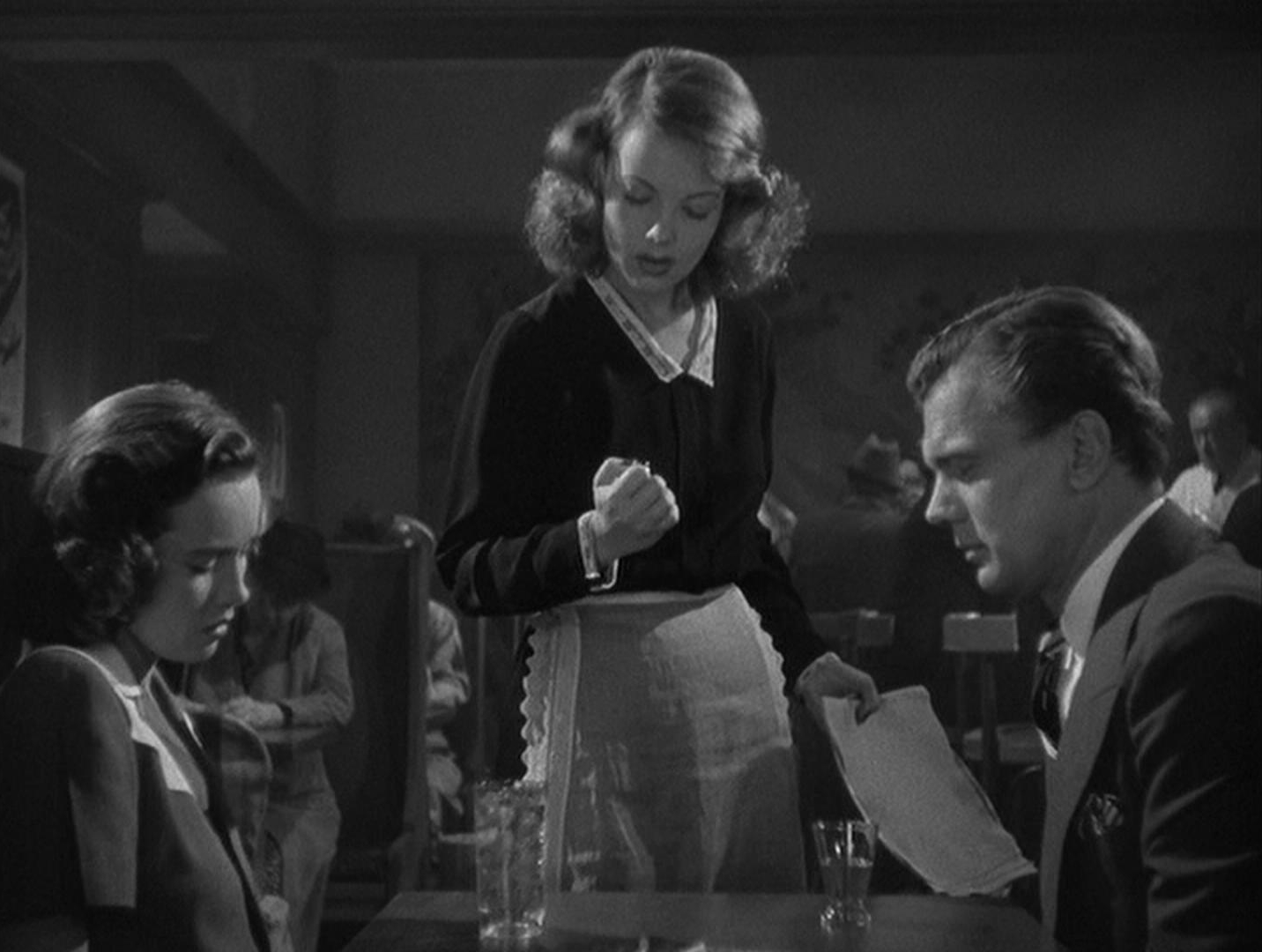
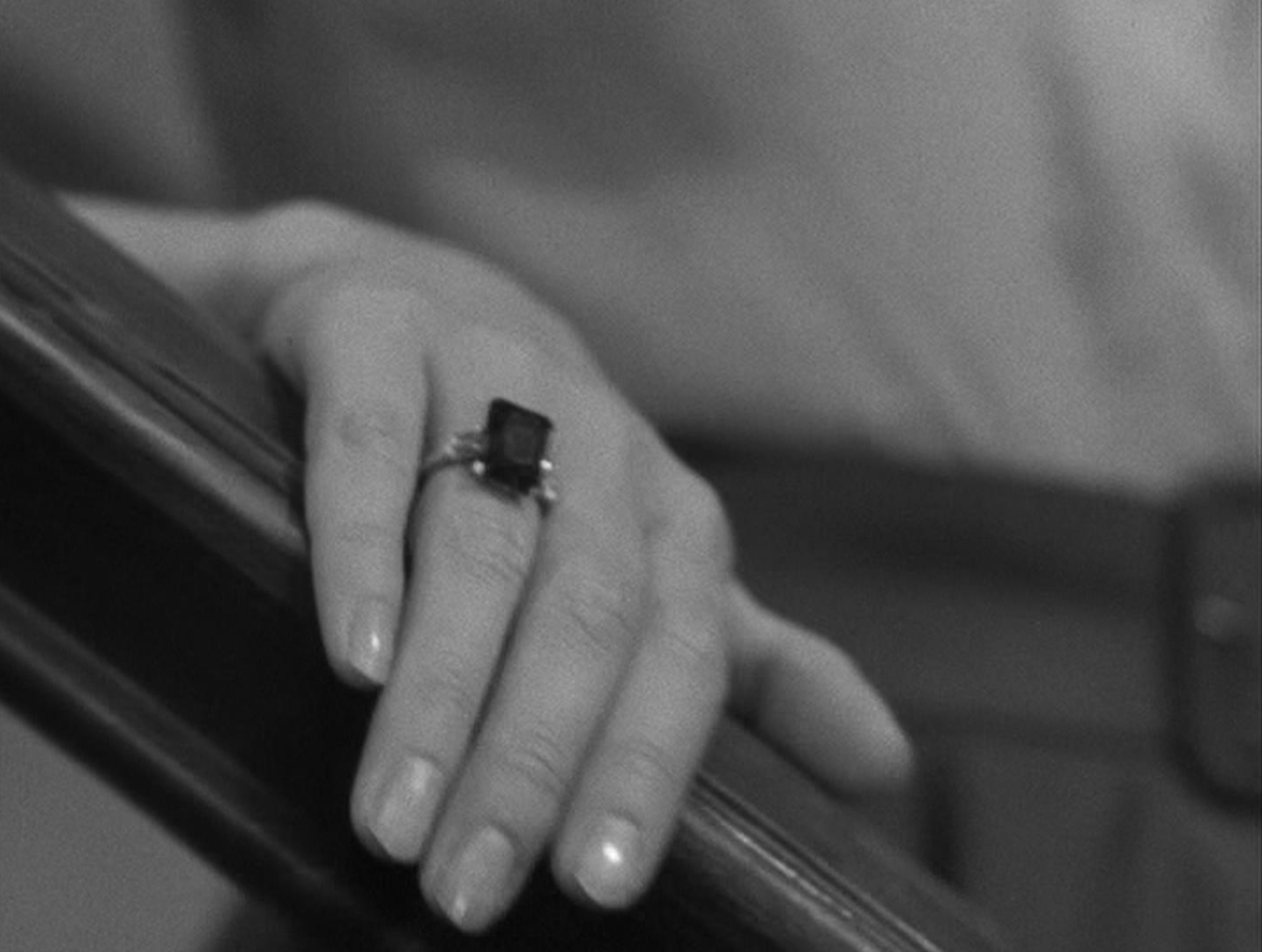
This ring is like Tolkien’s legendary ring because whoever gets it immediately holds the upper hand in the relationship. When Uncle Charlie arrives in Santa Rosa with the ring in his baggage, his niece is practically infatuated with him and always bends happily to his will, but as soon as he gives it up she turns the tables on him. First she throws him off balance by noticing the engraved initials, and then she tells him to bring coffee into the dining room. Now she is the one giving orders.
Later in the ‘Til-Two café, before the ring changes hands again, Uncle Charlie is still nervous around his niece and laughs sheepishly. When she puts the ring on the table, for a brief interlude it remains neutrally between them as the waitress drools over it, and the two Charlies both bow their heads as if drained of energy. Uncle Charlie then puts his hand over it, and he suddenly turns aggressive. This aggression will soon escalate into two murder attempts on his niece.
Finally, when Charlie comes down the stairs flashing the emerald ring to all the family and guests, her uncle does her bidding without hesitation and promptly announces his departure from Santa Rosa the next day.
This pattern is so consistent that in the climactic struggle on the train, Hitchcock finds it necessary to put the young Charlie in gloves. If her hands were exposed, there would be no suspense. Either we’d see the ring and know she’d prevail, or we’d see that she left it behind, in which case Hitchcock would either have to change the ending or weaken the pattern.
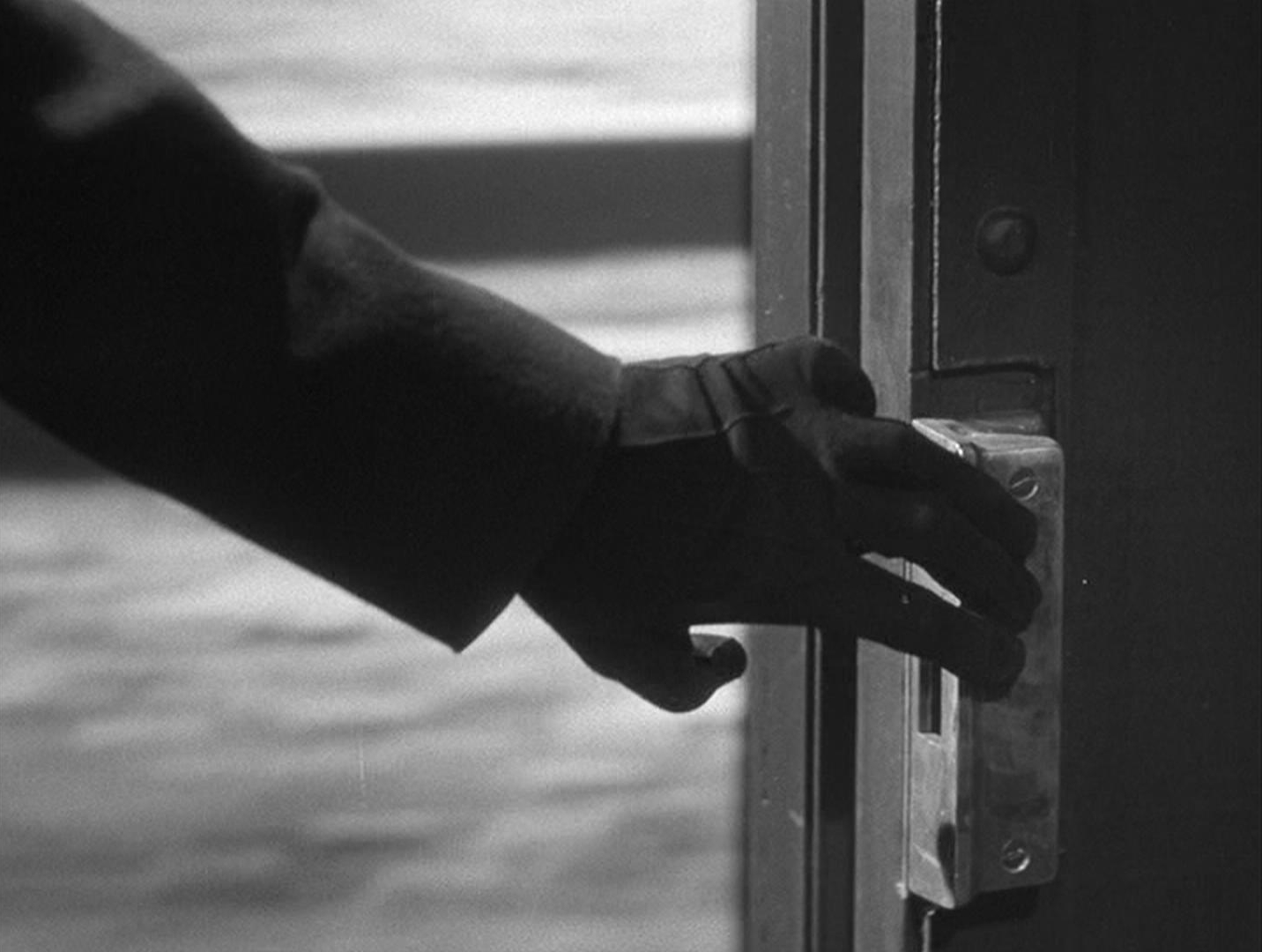
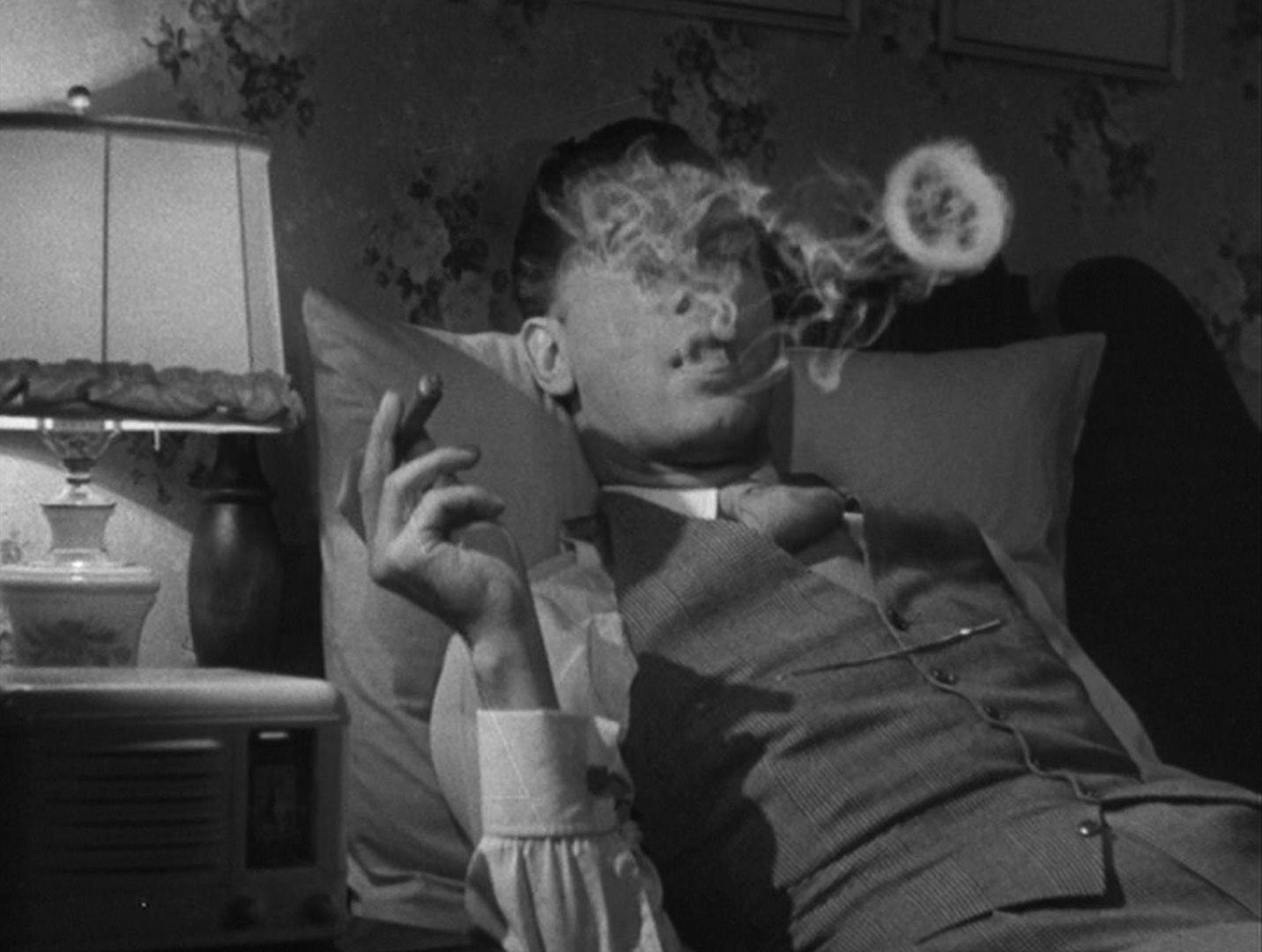
The image of the ring hovers over the whole movie, a subliminal testament to the object’s uncanny powers. Uncle Charlie blows a smoke ring in bed. Circles pop up conspicuously in all sorts of places – the ‘Til Two logo, the lenses of Ann’s and Herbie’s spectacles, the dashboard dials and steering wheel of the family car, clocks, the circular flow of the recurring waltz. When the two Charlies argue on the back porch about whether the uncle will leave, the silhouetted ring on the window shade’s drawstring hangs between them. When Uncle Charlie insists on staying, his head approaches and overlaps the loop, but when his niece warns him to leave, she approaches that surrogate ring as if drawing power from it. Earlier, when she still had the ring and wanted to get into the library after closing time, a similar drawstring had hung between her face and the librarian’s – its hanging ring working like a magical charm to get Charlie inside to check the newspapers.
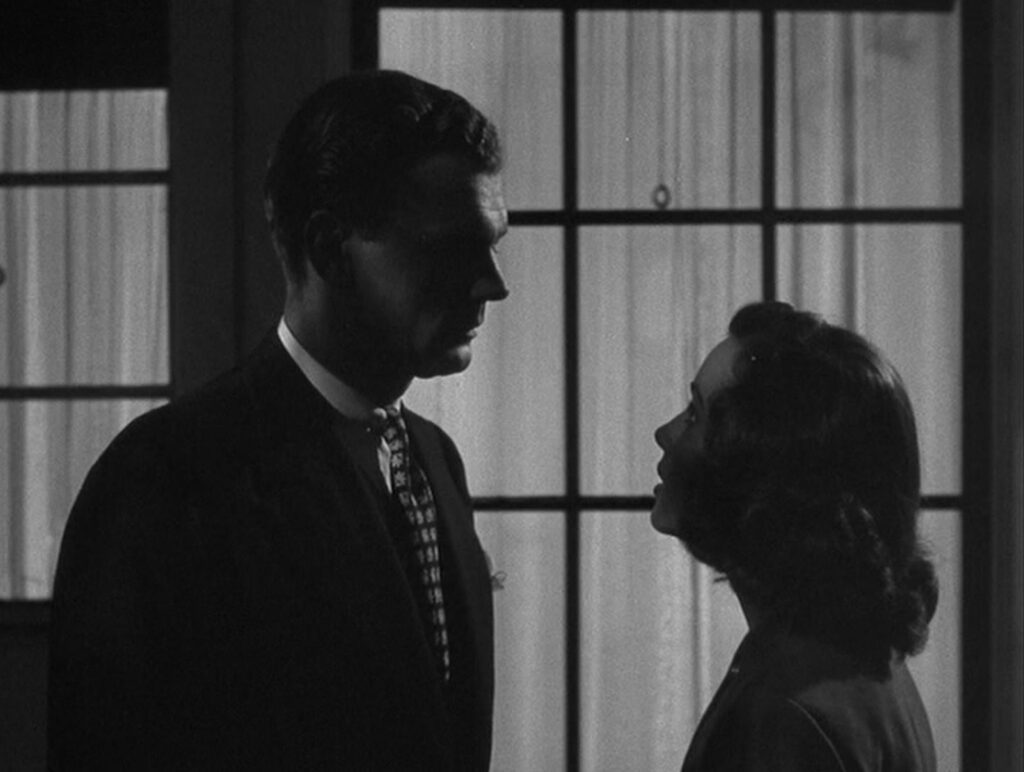
Hitchcock famously claimed, as late as 1972 near the end of his career, that Shadow of a Doubt was his favorite of his films. He surely knew what he had achieved in Vertigo, but that movie was a failure in the public’s eye, and it probably represented an unpleasant experience. In 1943 however his career was still rising; he was new to Hollywood, and Shadow of a Doubt marked a sense of discovery. He had already learned to invest his films with details that coalesced around an ulterior meaning, but the ring was a more elegant device than he, or almost any other filmmaker, had used before. It structures the film so naturally, and the object is anything but random. A ring is a symbol of marriage, and in that capacity it absolutely fits what Hitchcock wished to give his audience.
When Uncle Charlie slips a ring around his niece’s finger, the gift expresses a closeness that you’d expect between lovers – and she welcomes this closeness. The arc of Shadow of a Doubt takes Charlie from her quasi-incestuous attraction to her uncle, a metaphor for a girl’s Elektral stage, all the way to the cusp of maturity. At the end she and Detective Graham sit in front of a church, representing her readiness to marry a more appropriate man from outside the family.
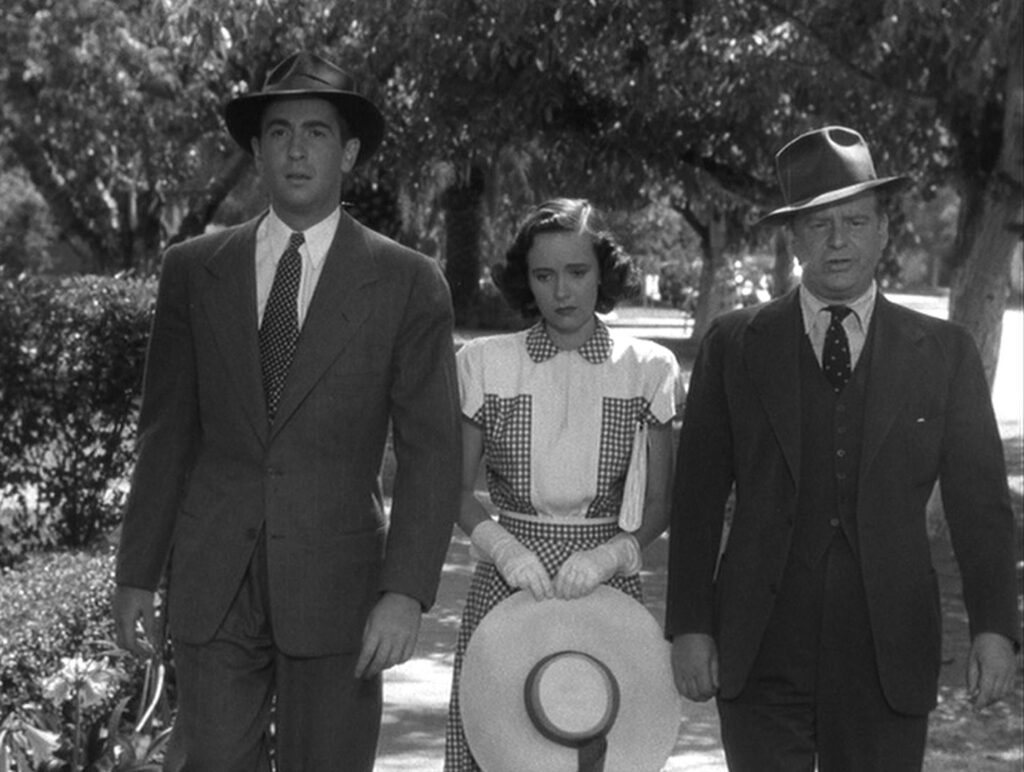
Again symbolizing the idea of marriage, Shadow of a Doubt is filled with pairs. There are two Charlies, two detectives, two policemen following Uncle Charlie in Philadelphia, two suspects in the case, two dinner scenes, two train scenes, two scenes by the church, and two murder attempts. Each of the two Charlies is introduced lying in bed; the uncle lives a double life; young Charlie has two younger siblings and two friends her age; the house has two floors connected by two stairways; and the local nightspot is called ‘Til Two.
The name ‘Til Two has a double meaning: literally it’s the establishment’s closing time, but it’s also a meeting place for young couples until they become two, i.e. get married. Like Victorian novels, Hitchcock’s movies value marriage as the ideal personal and social arrangement. Joseph Cotten’s character, the Merry Widow killer, who seduces widows with the prospect of marriage and kills them for money, represents a total betrayal of marriage, but his niece represents the normal arc of development that replaces the selfish drives of a child with social awareness and prepares individuals for the genuine intimacy of marriage.
It’s absolutely important that Charlie is introduced lying in bed, in the same position as her uncle, wishing for a more exciting life. The self-centeredness of a petulant child and that of an adult criminal differ only in that one is a normal, unavoidable phase while the other represents stilted growth. Over the course of the story Charlie will be figuratively punished for her wish, as she’s put through all the trauma and disillusionment of adjusting to reality. Hitchcock’s films uphold not only marriage but also ordinariness as a model for a functioning society. Shadow of a Doubt celebrates the virtues of ordinary life, both in Charlie’s family and in the all-American everyday life of Santa Rosa (which Hitchcock adopted as his own hometown). When she’s introduced Charlie rejects ordinary life, wishing (like any girl in her Elektral phase) to be special. The same motivation corrupts men like her uncle, who hold ordinary life in contempt and try to place themselves above it.
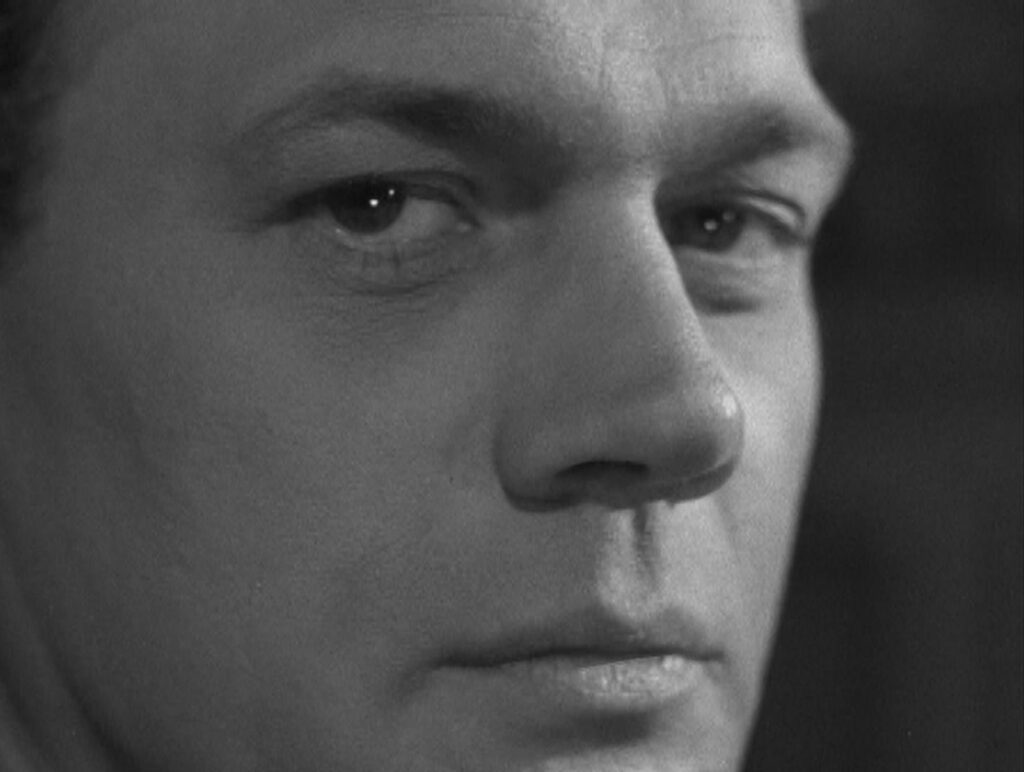
Hitchcock’s worldview may sound conservative in today’s context, and in a sense it is, but not in opposition to liberalism. In fact we must also realize how thoroughly opposed it is to fascism. Shadow of a Doubt was made in the middle of World War II, and like his overtly anti-fascist Saboteur the preceding year, it upholds American values in contrast to the corruption spreading through Europe. Again, as in Saboteur, California stands for a democratic society in the West where people accept their equality as ordinary citizens, in contrast to a corrupt East, pictured unflatteringly in the opening scene filmed in Newark, which (like New York in Saboteur) is symbolically tainted by its proximity to Europe.
In line with this east-west dichotomy there are recurring allusions to vampires throughout Shadow of a Doubt. Uncle Charlie is introduced lying in bed in broad daylight, and he rises like a vampire as soon as his landlady lowers the shade. On the train to California he rides in a sealed compartment. He comes from Pennsylvania, which rhymes with Transylvania, and Detective Graham tells Ann to “tell Catherine the story of Dracula.” Doubtless Hitchcock intended a sly and probably affectionate joke on the reputation of Universal Pictures, which was known in 1943 more for monster movies than for upscale pictures, but the idea of a vampire as a symbol of corruption coming from the east reinforces Hitchcock’s hopeful view of the United States as the savior of civilization from tyrannical authoritarianism. Fascism after all holds a special appeal to persons who wish, like Uncle Charlie or like his niece in her first scene, to be special.
As the antithesis to fascist Europe, Santa Rosa represents a society with minimal hierarchy. The real hierarchy in Shadow of a Doubt is not the separation between people of unequal power, but the separation between public and private life that the Newton home’s stairway represents. Like the ring, the doubling, and even the recurring vampire references, the stairway is another organizing device, helping Hitchcock to govern the myriad decisions that go into creating a motion picture, especially at a low-end studio like Universal where the director no longer had Selznick’s expensive creative team managing details.
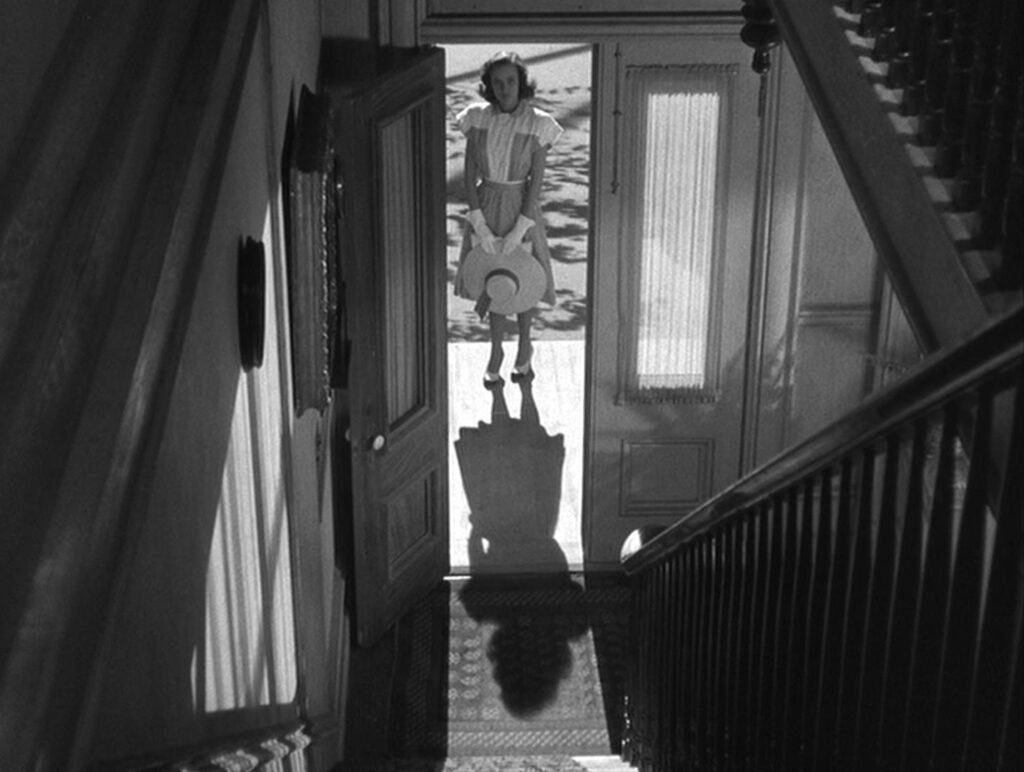
The first floor of the house, only a few steps above the street, is a virtually public zone where guests come and go, and Herbie can walk in without knocking. Upstairs is a zone reserved for private family life, and when the detectives go up there viewers will feel they’re intruding. When Uncle Charlie hears that the other murder suspect was killed in an airplane propeller, he bounds triumphantly up the stairway, but as he nears the top he grinds to a halt, arches his back, and turns to see his niece’s accusing stare below. In the public arena he’s been acquitted, but in the private arena, within his family, he is still guilty. Finally, when young Charlie locates the ring and comes downstairs wearing it, she threatens to make her uncle’s guilt public.
The staircase, the ring, and the other devices are conveniences for Hitchcock, telling him how to stage dramatic scenes like Uncle Charlie turning around to face his niece below, or the argument by the drawstring. Ultimately however they are more than conveniences. They come together to illustrate the kind of world Hitchcock wanted to live in, a mature and democratic society where the private life of a married couple is the only thing elevated above ordinary public life.
CONNECTIONS:
I Was Born, But… – Circles as an organizing device
The Lady Vanishes – Protagonist who grows out of her Elektra complex
The Little Foxes – Teresa Wright at the bottom of a stairway confronts an opponent near the top who realizes her/his losing position
Ornamental Hairpin – Celebration of ordinary life in a time of global warfare
Suspicion – Hitchcock film with a recurring waltz melody; story of a woman suspicious of a man; undercurrent of juvenile sexuality
Saboteur – Ode to ordinary American life; California stands for the virtue of the West, with tyranny/crime spreading from the East
Strangers on a Train – Strangler who’s cozy with older women; girl with crush on adult uncle or sister’s boyfriend, transfered later onto a policeman
Rear Window – Starts with a character’s boredom; flashing ring; ends with idea of marriage
Le beau Serge – A sophisticated city dweller returns to family or friends in a small community, disrupting their lives; extensive doubling
Les bonnes femmes – Vampire metaphor applied to a man who preys on women
Cléo from 5 to 7 – Feeling of the story changes when an object (ring/hat) changes hands
The Servant – Staircase separating two domains, public vs. private or high vs. low
Charulata – A bored young woman figuratively conjures up the visit of a male relative who brings romance and danger into her life
Black Girl – Symbolic object (ring/mask) confers power/agency/control on its holder
Diva – Profusion of doublings that ultimately point to the duality of a couple
Blue Velvet – Youth on cusp of adulthood tempted by excitement from a “dark side” linked with incest; contest between ordinary America and an underworld of crime
Antareen – Symbolic power invested in an ordinary object; ambiguity of gloves at end / ambiguity of last glass and thermos